Scandinavian-American Line Archival Collection

Det Forenede Dampskibs-Selskab Aktieselskab - The United Steamboat Company Corporation operates as the Scandinavian-American Line (Skandinavien-Amerika Linien).
In the early years, many immigrants from Scandinavia and the Baltic States crossed the ocean to the New World in ships from the Scandinavian-American Line.
Favored in the early 20th century, alike by those who crossed the Atlantic for pleasure and for business, the Scandinavian-American Line -- the descriptive name under which the company operated its passenger service between the United States and the Scandinavian countries -- typifies everything that made ocean travel a delight.
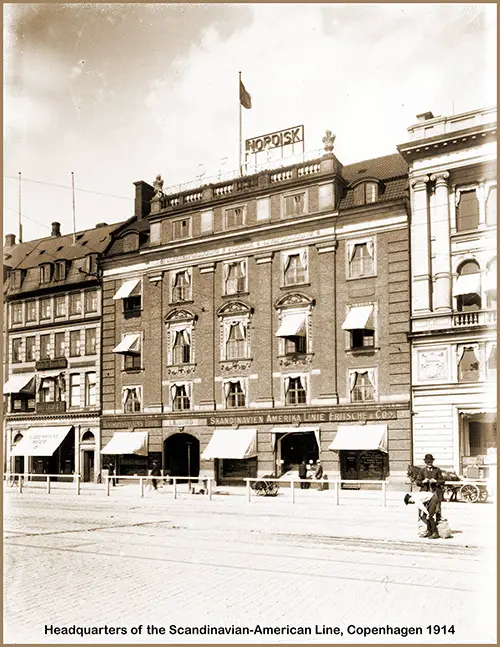
Headquarters of the Scandinavian-American Line at Kongens Nytorv 14 in Copenhagen, Denmark, 1914. GGA Image ID # 1d473261b0
Scandinavian-American Line Ephemera in Date Order
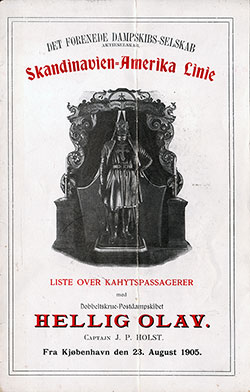
1905-08-23 SS Hellig Olav Passenger List
- Class of Passengers: First and Second Cabin
- Date of Departure: 23 August 1905
- Route: Copenhagen to New York
- Commander: Captain J. P. Holst

1907-07-04 SS C.F. Tietgen Passenger List
- Class of Passengers: Cabin
- Date of Departure: 4 July 1907
- Route: Copenhagen to New York
- Commander: Captain A. G. Thomsen
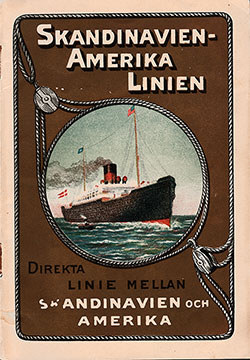
1912 Brochure - Scandinavian-American Line - Scandinavia to America
50-Page brochure from the Scandinavian-American Line promoting their service from Scandinavia to New York focused on Third Class accommodations and persuading immigrants to cross the Atlantic on one of their steamships.

1912 Broschyr - Skandinavien-Amerika Linien - Skandinavien och Amerika
50-sidars broschyr från den skandinavisk-amerikanska linjen som främjar deras tjänster från Skandinavien till New York fokuserade på tredje klassens boende och övertalade invandrare att korsa Atlanten på ett av sina ångfartyg.

1912-02-08 SS United States Passenger List
- Class of Passengers: Not Stated
- Date of Departure: 8 February 1912
- Route: Copenhagen to New York
- Commander: Captain R. Gøtsche
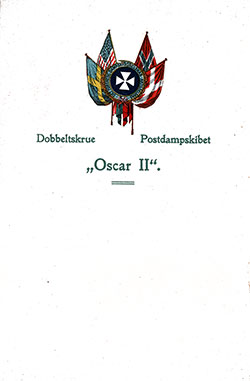
1912-05-16 SS Oscar II Dinner Menu
Vintage Dinner Menu from Thursday, 16 May 1912 featured Roast Duck with Potatoes, Soup of Asparagus, and Cream Cake for dessert. Menu printed in Danish and English.

1914-08-13 SS Oscar II Passenger List
- Class of Passengers: First and Second Cabin
- Date of Departure: 13 August 1914
- Route: Copenhagen to New York
- Commander: Captain J. Hempel

1916-11-14 SS Frederik VIII Passenger List
- Class of Passengers: First and Second Cabin
- Date of Departure: 14 November 1916
- Route: Copenhagen to New York
- Commander: Captain A. G. Thomsen

1917 Brochure - Scandinavian-American Line Direct Services
1917 Brochure covers History, Fleet, Accommodations (First, Second and Third Class), Connections at Ports, Information on Scandinavia and Offices and Agencies. Numerous interior photographs make this brochure exceptional.

1919-12-09 SS Frederik VIII Passenger List
- Class of Passengers: First and Second Cabin
- Date of Departure: 9 December 1919
- Route: Copenhagen to New York
- Commander: Captain A. G. Thomsen, R. AF D., DM
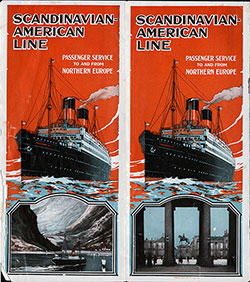
1920s Brochure - Cabin Service to Northern Europe
16-page brochure from Scandinavian-American Line is devoted to their cabin service to and from Northern Europe. It contains information for passengers about their fleet and cabin accommodation.

1920-08-05 SS Frederik VIII Passenger List
- Class of Passengers: First and Second Cabin
- Date of Departure: 5 August 1920
- Route: Copenhagen to New York
- Commander: Captain R. Gøtsche, R. AF DBG
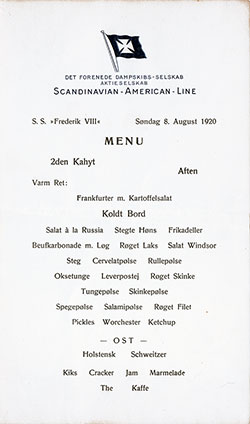
1920-08-08 SS Frederik VIII Dinner Menu Card
Vintage Second Cabin Dinner Menu Card from Sunday, 8 August 1920 featured Frankfurter with German Potato Salad, French Marinated Beef Dish (Carbonnade de Boeuf), and Smoked Ham. A Danish menu that emphasizes meat and cheeses to make open faced Danish sandwiches that are very common throughout Denmark and especially Copenhagen.

1921-08-12 SS Hellig Olav Passenger List
- Class of Passengers: First and Second Cabin
- Date of Departure: 12 August 1921
- Route: Copenhagen to New York
- Commander: Captain L. F. Peronard

1921-11-06 SS Hellig Olav Passenger List
- Class of Passengers: First and Second Cabin
- Date of Departure: 6 November 1921
- Route: Copenhagen to New York
- Commander: Captain L. F. Peronard

1922-12-12 SS United States Passenger List
- Ship: SS United States
- Class of Passengers: Cabin
- Date of Departure: 12 December 1922
- Route: Copenhagen to New York
- Commander: Captain V. Voldborg
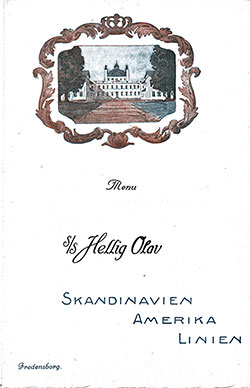
1923-06-25 SS Hellig Olav Dinner Menu
Vintage Cabin Class Dinner Menu from Monday, 25 June 1923 on board the SS Hellig Olav of the Scandinavian-American Line featured Boiled Striped Bass with creamed Horseradish, Roast Loin of Veal Cauliflower à la hollandaise, and Ruben Steiner Cake for dessert. A Music Program was included with the menu.
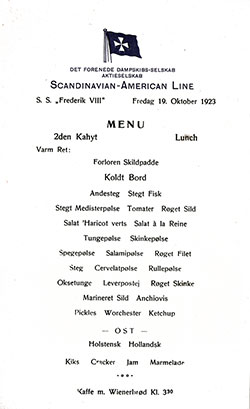
1923-10-19 SS Frederik VIII Luncheon Menu
Vintage Luncheon Menu from 19 October 1923 featured Mock Turtle, Roast Duck, and Anchovies for Danish Soup and Sandwiches. Menu printed in Danish Only - Primarily Scandinavian dishes.

1924-02-07 SS Frederik VIII Passenger List
- Class of Passengers: Cabin
- Date of Departure: 7 February 1924
- Route: Copenhagen to New York
- Commander: Captain F. Mechlenburg
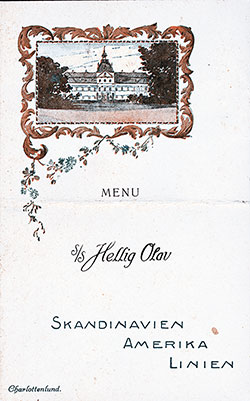
1924-05-10 SS Hellig Olav Dinner Menu
Vintage Cabin Dinner Menu from 10 May 1924 featured Boiled Salmon, Sauce Mousseline, Calf’s Sweetbread à la Marachale, and Parfait Aida for dessert. The menu was published in Danish and English and included a Music Program.

1924-05-15 SS United States Passenger List
- Class of Passengers: Cabin
- Date of Departure: 15 May 1924
- Route: Copenhagen to New York via Halifax NS
- Commander: Captain V. Voldborg

1925-08-14 SS Oscar II Passenger List
- Class of Passengers: Cabin
- Date of Departure: 14 August 1925
- Route: Copenhagen to New York
- Commander: Captain A. J. Schmidt

1928-02-01 Scandinavian-American Line Tourist Third Cabin Brochure
8-Page brochure from the Scandinavian-American Line packs a lot of information and interior photographs of their Tourist Third Cabin accommodations, rates of passage, and other information for passengers. Produced by the New York office for American tourists to Europe.

1929-07-29 SS Hellig Olav Passenger List
- Class of Passengers: Cabin
- Date of Departure: 27 July 1929
- Route: New York to Copenhagen via Christiansand and Oslo
- Commander: Captain L. F. Peronard

1931-05-29 SS Frederik VIII Passenger List
- Class of Passengers: Cabin and Tourist Third Cabin
- Date of Departure: 29 May 1931
- Route: New York to Copenhagen via Kristiansand and Oslo
- Commander: Captain F. Mechlenburg
Other Ephemera
1932 Brochure: Excursion to Scandinavia, Scandinavian Fraternity of America, Sponsored by Seattle Lodge No. 61. Leave New York on May 28 on board the Scandinavian-American Line flagship Frederik VIII. 12 Panels (Fold Out). Photographs include: SS Frederik VIII, Cabin on Steamer, and other destination scenes.
1913 Hat Ribbon (Cap Tally) Frederik VIII - Gold Lettering on Black Ribbon with Skandinavien Amerika Linen crest on both sides (Logo with flags of Sweden, US, Norway and Denmark (Clockwise).
Neutral Flag: The Scandinavian-American Line (1916)
The neutral flags that sail out of our ports are performing a most essential service in keeping alive our communications with Europe in these war-stricken times.
The various lines operating between New York and Scandinavian points have, with trifling exceptions, kept their service uninterrupted. Their ships are richly laden with freight, and new trade routes spring up overnight.
In these perilous days, their passengers have traversed the seas without serious danger from torpedo or mine.
Three years ago, in an article in the Review on “The Revival of Norway’s Dominion on the Sea,” Director Bryde recounted the inception of the Norwegian America Line and of the Norway-Mexico Gulf Line.
An editorial in the current issue announces the actual inauguration of a new passenger service under the flag of Sweden.
The present article will sketch in brief outline the history of the pioneer in whose wake these lines have followed—the route whose ships wear the red and white cross of Denmark painted bright, on their sides. “The Danish Line” is known officially as the Scandinavian-American Line.
The Scandinavian-American Line is what its name implies—a link between Scandinavia and America. As the pioneer in establishing direct routes for transportation of passengers and freight between the Scandinavian countries and the United States, it justly deserves much credit for the friendly and intimate relations prevailing between these nations.
Then it is living testimony in the hundreds of thousands of sturdy immigrants whom the Line has brought to America during the thirty-five years of its existence, and who are now counted among the best of American citizens.
In the hundreds of thousands of Americanized Scandinavians carried back to their old homes for friendly visits; in the thousands of native American tourists whom the direct route has induced to visit Norway, Sweden, and Denmark and become acquainted with the grandeur and charm of the North.
The Scandinavian-American Line is hut a name given that branch of the service of the United Steamship Company of Copenhagen (Det Forenede Dampskibsselskab) engaged in the direct New York-Christiansand. Christiania, and Copenhagen route, and particularly to the sender of the four passenger and mail steamers, Oscar II, Hellig Olav, United States, and Frederik VIII.
The United Steamship Company is a Danish organization formed in 1866 by amalgamating several smaller concerns. It commenced business with a fleet of twenty-two steamships having a total register tonnage of 4,919 tons.
In the beginning, only ports of Denmark, Norway, and Sweden were served, but later still other steamship companies were absorbed, and the wise and enterprising management rapidly added more steamers and extended the service to distant ports.
Just before the outbreak of war, this company-owned one hundred and forty-four steamers with a register tonnage of 185,444 tons, and maintained regular service not only to various ports in Denmark and the sister countries of Sweden and Norway, but to ports in Germany and Russia on the Baltic, to Iceland and Faroe Islands, to Scotland, England, Holland, Belgium, France, Portugal, and Madeira, and to various ports on the Mediterranean extending even to the Levant and the Black Sea.
Routes had also been established crossing the Atlantic to Brazil and Argentina in South America and to Galveston, New Orleans, Savannah, Newport News, Baltimore, Philadelphia, New York and Boston in North America. Traffic with the Orient, on the other hand, is left to another well-known Danish commercial enterprise, the East Asiatic Company.
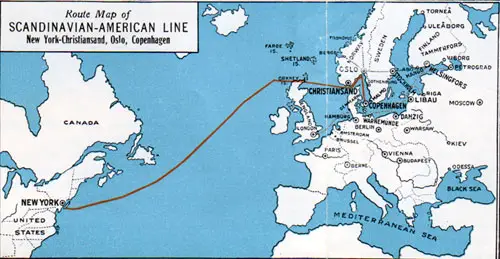
Route Map of the Scandinavian-American Line
All American connections are freight routes exclusively, except that, to and from New York, known as the Scandinavian-American Line, which is a regular passenger and mail service between New York and Christiansand, Christiania, and Copenhagen.
This direct passenger service was initially begun in 1880 by the Thingvalla Steamship Company, which after having led a somewhat checkered career was finally taken over about fifteen years ago by the United Steamship Company, which continued the service under the name of the Scandinavian-American Line.
With its usual enterprise and farsightedness caused to be built the steamers SS Oscar II, SS Hellig Olav, and SS United States, each 51.3 feet long and 10,000 tons displacement, and equipped with every safety device, modern comfort, and luxury, and particularly adapted to the demands and requirements of the fastidious Scandinavian passenger.
On these steamers, the first and second cabins are unusually spacious and comfortable. But the most distinctive feature, perhaps, of their appointment is the third class, which provides a degree of comfort formerly unknown in this class of ocean travel.
The open steerage floorplan was abolished, and instead, there was for the first time introduced small cabins for the accommodation of two or four persons, neat dining rooms, and sitting rooms, that have resulted in a continually growing patronage.
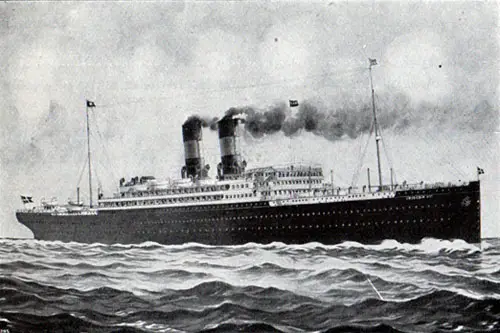
The SS Frederik VIII of the Scandinavian-American Line
In 1914 the new steamer Frederik VIII made its maiden trip. It is the largest steamer ever built for the Scandinavian service, being 542 feet long, 62 feet wide and 41 feet deep from the upper deck to bottom and displacing 18,000 tons. It is completely equipped with modern appointments, affording a degree of luxury and comfort unsurpassed on any liner of its size afloat.
All of the steamers are particularly well supplied with lifesaving apparatus, providing boats far above the highest number of passengers and crew ever carried; the Frederik VIII has even a motor lifeboat. Two wireless operators are onboard, one always being on duty at sea.
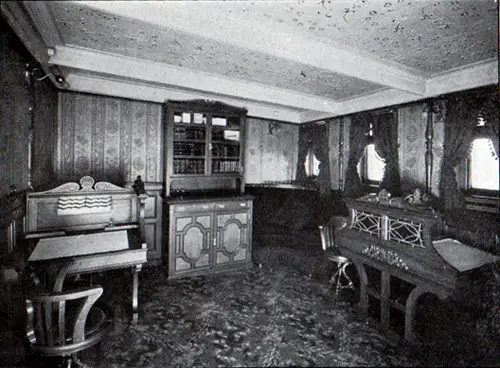
First Cabin Writing Room on the Oscar II and Helig Olav of the Scandinavian-American Line
Libraries of selected works in the Scandinavian, English, and other European languages are found in each of the three classes. Each steamer carries an orchestra of skilled musicians, and the third class is treated to daily concerts as well as the first. Also, the cuisine is justly famed both for its staying powers and novelties, combining wholesomeness and a high degree of artistic excellence.
The Scandinavian-American Line has always chosen its route to please the tourist. The first port of call in Norway is Christiansand, where a stop is made to land passengers and mail, and where connections are provided for remote Saetersdal, the Norwegian coast, and Southern Norway; the journey is then continued up the beautiful Christiania Fjord to Christiania.
Here a stop of several hours is made, allowing ample time for those continuing on the steamer to Copenhagen to see the capital, inspect the exhumed Viking ships, visit the museums, take a trip up the forest-clad mountainside to the delightful Holmenkollen Hotel and to lunch sumptuously while enjoying a most beautiful view of city, fjord, and surrounding country.
Picturesque Telemarken may be reached from Christiania. Tourists, who intend to visit the North Cape, or the mountains in western and northern Norway, proceed from Christiania to Bergen over the scenic Bergen-Christiania Highland Railway. It will not be necessary to retrace steps after having been to the North Cape, as the journey may be continued by rail through the wooded hills and across the rushing rivers of northern Sweden to Stockholm.
Having inspected the many places of historical interest and visited the numerous art galleries and museums of Sweden’s aristocratic and beautiful capital, and after having made short but interesting trips to Uppsala and Dalarna, or across the Baltic to ruined Visby, the tourist may continue the journey by most comfortable steamers straight across Sweden, past hills and lakes on the Gota Canal to Gothenburg.
This unique trip, which permits many small excursions on foot, while the steamers are going through the locks, to old churches and other points of interest, takes two and a half days. From modern Gothenburg, Sweden’s busiest port, to Copenhagen is but a rail journey of seven hours.
The passenger who elects to continue on his steamer from Christiania arrives after a night’s run in Copenhagen, the largest city of Scandinavia, with its art galleries and museums, and Denmark with its castles and manors, prosperous farms and leafy beech woods, hotels for tourists, and bathing resorts by the sea. Christiania offers rail connection with Finland and Russia, and Copenhagen opens the door to the Continent.
To the dean of the Scandinavian passenger service in this country, Mr. A. E. Johnson is due more than to any other person the awakening of American interest in the possibilities of the North as a tourist land. It was no doubt in recognition of this fact that he was chosen in 1911, with Consul C.A. Smith of Minnesota and California, as one of the two Swedish-born trustees of the American-Scandinavian Foundation.
The passenger department in America for over twenty-five years has been in charge of Messrs. A. E. Johnson & Co., composed of Hon. A. E. Johnson, former Swedish Consul at New York, and Mr. Max Straus. In 1914 Mr. Halvor Jacobsen, a Dane by birth, but in America since early childhood, formerly General Passenger Agent at San Francisco, entered the firm, the name of which was changed to A. E. Johnson & Co., Inc.
Since Mr. Johnson was taken ill in November 1914, the passenger department has been under the exclusive management of Mr. Jacobsen. General offices of the Line arts maintained in New York, and in Boston, Chicago, Minneapolis, San Francisco, and Seattle in Toronto, Ontario, and representatives are found in almost every town and city in the United States and Canada.
“Neutral Flags: The Scandinavian-American Line,” in The American-Scandinavian Review, Volume IV, Number 2, March-April 1916, New York: The American-Scandinavian Foundation, P. 106-110.
Story of the Scandinavian-American Line
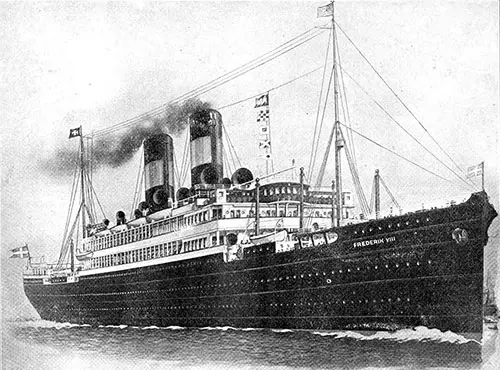
The Frederik VIII of the Scandinavian-American Line, 12,000 Tons Register, is a Luxurious and Deservedly Popular Passenger Vessel. GGA Image ID # 141ebbee4c
Rapid expansion of transatlantic services of the United Steamship Company of Copenhagen.
SERVICE has been the constant keynote of the United Steamship Company of Copenhagen ever since its inception. And the growth and steadily perfected development of this ideal of Service is strikingly shown in its present Important position.
Favored today, alike by those who cross the Atlantic for pleasure and for business, the Scandinavian-American Line— the descriptive name under which the company operates its passenger service between the United States and the Scandinavian countries—typifies everything that makes ocean travel a delight.
For those whose destination lies in the Scandinavian countries—Denmark, Sweden and Norway—or Germany, Finland, Russia and the other adjacent European countries, and for those who seek to travel by a route that has everything to commend it from the standpoint of convenience, scenic attraction, historical association and new sensations, this company offers an exceptional service and equipment.
The United Steamship Company of Copenhagen Amalgamating several smaller shipping firms, the United Steamship Company of Copenhagen was formed in 1866 and began business the following year.
With a fleet of 22 steamships, having a total register tonnage of 4,919 tons net, regular routes were maintained between the various ports in Denmark, and in addition, to Kiel, Stettin, Koenigsberg, Antwerp, London, Hull, several Norwegian ports, the Faroe Islands and Iceland.
Expansion was rapid, and the Company steadily enlarged its fleet and business area, increasing its own facilities by fusing with other companies. As a natural result of this aggressive, definite, foresighted policy, by 1872 this company was the principal factor in the water shipping traffic between Copenhagen and other Danish Ports.
1875 saw the completion of the harbor of Esbjerg, on the| west coast of Jutland, and with it the regular operation of a line of steamships between that port and England.
1880 was the date of still further expansion, when the important export routes for agricultural products, between Copenhagen and Newcastle, England, were taken over.
This was followed closely by the acquisition of still other routes between Danish provincial ports and Newcastle. And it is noteworthy, that since 1884 the handling of Danish agricultural exports to England (with the exception of the route between Copenhagen and Leith) has been taken care of solely by this company.
1882. Shortly after the opening of the St. Petersburg Ship Canal, the company again broadened its activities, and a line of steamships was put in operation between Antwerp and St. Petersburg.
1883 was likewise an important development year. It saw the extension of the company’s service to Havre as a port of regular call; and a still further extension of its service to Mediterranean ports.
1886. was another progressive year, when a route to Hamburg was established; and one between Antwerp and Riga.
1887. opened up still other new routes—one to Hango (Finland) and one to Oporto-Lisbon, with the extension of this route to Madeira in 1893.
1895 marked an epoch in the company’s history. Busy as they had been up to this time, in developing their many European routes, attention was now turned to the development of the company’s first route between Copenhagen and United States ports.
Six big steamships were built and named Kentucky, Arkansas, Louisiana, Florida, Alabama and Texas. These steamships plied between Copenhagen and New Orleans, and in addition to great cargo capacities provided accommodations for a limited number of cabin passengers.
The Scandinavian-American Line
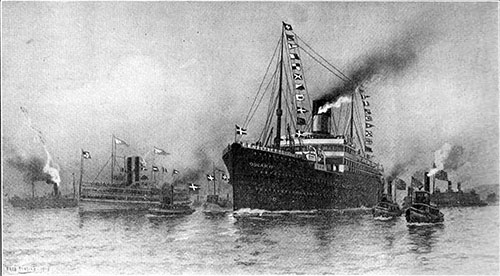
The Scandinavian-American Liner Oscar II, 10,000 Tons Register, is a Splended, Modern, Twin-Screw Steamer. GGA Image ID # 141ec77c17
1898 witnessed still more important developments, for in this year the company took over the “Thingvalla Line,” a long-established passenger service line between Copenhagen and New York.
With the accession of this line, immediate steps were taken to put its trans-oceanic service on the highest plane of efficiency. New twin-screw steamers of the most modern type were built expressly for this service between Scandinavian ports and New York. This service is known as the Scandinavian-American Line.
1899 the company established a regular service between Boston and Copenhagen.
1903-1904 initiated the opening of regular sailings between Scandinavian ports and Philadelphia, Newport News and Baltimore.
1907 saw still another addition to the company’s service, with the establishment of the line to Buenos Aires, South America.
And as a result of this steady progress, of this Intelligent expansion of its service, by the end of 1913 the company’s fleet Included 130 steamships and 14 seagoing lighters, with, a total gross tonnage of 177,290 tons.
1914 the service of the Company’s Lines was still further augmented with the commissioning of several new ships. The most notable of these were the “California,” the largest vessel afloat driven by Diesel motor engines; and the magnificent passenger steamer “Frederick VIII.”
An Up-to-Date Fleet
No more popular steamers sail the broad Atlantic than the splendid modern twin-screw steamers of the Scandinavian- American Line which maintain a regular direct service between New York and Scandinavian ports. The fleet comprises:
The Frederick VIII, 12,000 tons register, 18,000 tons displacement, 542 feet long, 62 feet wide, 42 feet from keel to upper deck, built by the renowned Vulcan Shipbuilding Company at Stettin.
The Oscar II, the Heilig Olav, and the United States, each 10,000 tons register, 16,000 tons displacement, 515 feet long, 58 feet wide, 42 feet from keel to upper deck, built at the famous shipyards of Alexander Stephen & Sons, on the Clyde.
Designed and built expressly for the Scandinavian-American Line, with every known contrivance for safety, speed and comfort, these twin-screw steamers, constructed of steel throughout, are equipped with double cellular bottoms, watertight compartments and bilge keels to insure maximum steadiness at sea.
By any of these exceedingly popular steamers, passengers can reach the Scandinavian countries and neighboring Baltic ports with unexcelled ease and convenience.
The voyage occupies about 9% days, except on the steamer Frederick VIII which takes only 8V2 days, and It offers an attractive, quick, and comfortable way to travel, whether the ultimate destination be in Scandinavia or one of the adjacent continental countries.
Unique and Picturesque Route
Scandinavian-American Line steamers sail from the Company’s dock New York Harbor. The route takes the ships north of Scotland to Christiansand, Norway, the first port of call.
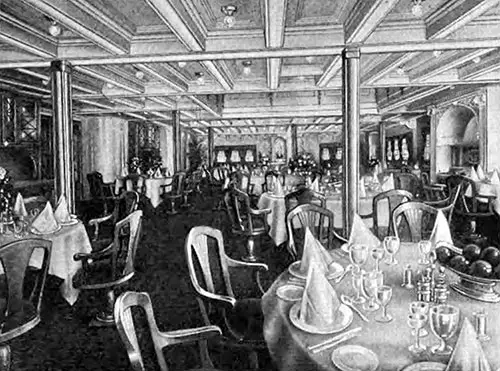
First Class Dining Saloon on the Frederik VIII. GGA Image ID # 141ef0218b
Then up the beautiful Christiania Fjord to Christiania, where sufficient time is allowed to permit of short visits to the Norwegian Capitol and its environs. (Tourists going to the North Cape to see the Midnight Sun, or to make the Fjord cruises, may stop over to see Southern Norway before proceeding.
Passengers booked to Bergen receive free transportation from Christiania, via the world- famed scenic Christiania-Bergen Highland Railway. Fast and comfortable trips can be made from Christiania by railway to Northern Sweden, to Gothenburg, Stockholm, and by steamer from Stockholm to Finnish points.) And finally, the steamers make an over-night run from Christiania to Copenhagen, Denmark.
This home port is the ideal connection for the principal cities of Europe, and particularly those in Germany. Austria and the eastern countries of the continent.
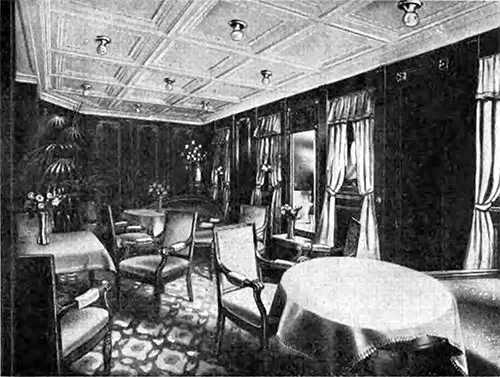
First Class Ladies' Lounge on the Frederik VIII. GGA Image ID # 141efac94b
For the sightseer on pleasure bent, and for the traveler who desires a combination of restful ease and rare enjoyment in his traveling, the facilities and superiorities of this route are many, and time proven.
Luxurious Accommodations Provided
The photographs reproduced on these pages illustrate the refinements of luxury and comfort of which the lack of space prevents a more detailed description.
The First Cabin Staterooms (for one, two, three or four passengers) are situated amidships on the four upper decks, and there are also two attractive suites of sitting room, bedroom and bath, on Frederick VIII.
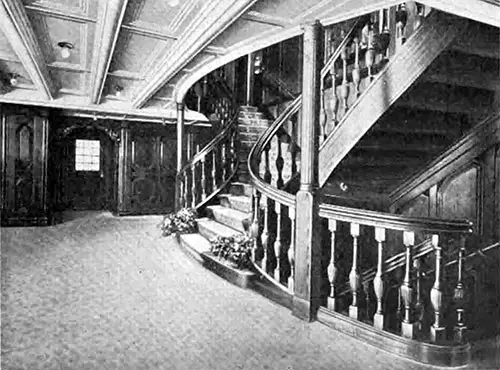
Grand Stairway, Frederik VIII. GGA Image ID # 141f539877
The Second Cabin Staterooms (for two, three or four passengers) are pleasantly located on the upper and saloon decks, with the Ladies’ Saloons, Writing Rooms, Lounges, Smoking Rooms, etc.
These cabins, as well as the staterooms, are all furnished in the same comfortable style as the first cabin. Cabin travelers on Oscar II have the entire ship at their disposal, without restriction; for this ship is limited to a One Cabin Service (second) in addition to the third class. There is a superbly furnished chambre-deluxe on the promenade deck.
Big roomy decks afford space for casual strolls, exhilarating walks, and for dancing to the music of an orchestra whose daily concerts are a delightful attraction.
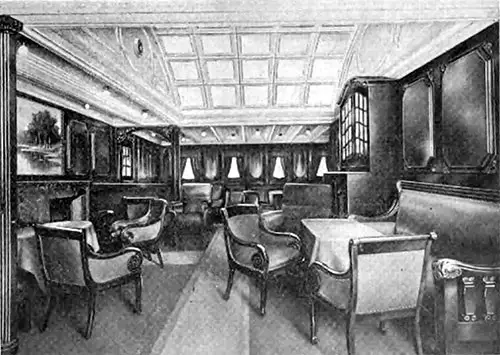
First Class Smoking Room on the Frederik VIII. GGA Image ID # 141f72859e
The wireless telegraph service to all parts of the world makes possible a regularly published newspaper of the world’s news, to supplement the ships’ .libraries, and the snug nooks on deck encourage restful reading outdoors in the sea air.
Each steamer carries a physician and trained nurse; and the photographers’ dark room, barber shops, and numerous baths, are but a few of the conveniences provided. All the many safety appliances are kept efficient by constant, thorough inspection.
The choicest delicacies and staple foods, from the markets of Europe and America, prepared by skilled chefs, afford a cuisine unexcelled by even the finest hotels. This result of forty years' experience In culinary service is the pride of the Scandinavian-American Line.
The ships’ officers are experienced men. whose rare qualities as gentlemen and skilled navigators have done so much to win the friendship and confidence of many hundred thousands of travelers.
The Chief Steward’s forces, besides their personal fitness, are schooled in Courtesy, politeness, and the immaculate cleanliness that constitutes ideal of service.
In all the world, there are no lands which surpass Norway, Sweden, and Denmark. The lands of charm, romance, and tradition; of hospitality; of scenic grandeur; of sports and pastimes of the great outdoors.
To the traveler seeking an ideal vacation realm; to the seeker after health and vigor; to the lover of the picturesque; to the hunter and fisherman— these beautiful countries of the North extend a hearty invitation.
And with the countless thousands who each year cross the Atlantic the Scandinavian-American Line continues to grow in favor. Every year more and more travelers select the steamers of this line because of their extreme steadiness, their comfortable accommodations and their high standard of service.
New Home Office for America
The Scandinavian-American Line recently moved into its own new seven-story building at 27 Whitehall Street, New York. The structure was erected at a cost of $400,000 and is regarded as an architectural gem.

The Scandinavian-American Line's New Building at 27 Whitehall Street, New York. GGA Image ID # 141f7a12aa
The first floor, the basement and the mezzanine are occupied by the Scandinavian- American while the other offices have been leased to other tenants. The Danish consulate occupies one of the seven floors.
The first floor is given over chiefly to the cabin department. although Halvor Jacobson, the general manager of the line in the United States, has his office located in the front. The scheme of austere simplicity has been followed, with the fixtures in mahogany and the walls and floors in marble.
The third class department is located in the basement. On the mezzanine there is a meeting room for general conferences and other smaller offices.
"Story of the Scandinavian-American Line," in Shipping, Marine Transportation, Construction, Equipment, and Supplies, New York: Shipping Publishing Company, Inc., Vol. XIV, No. 8, 25 October 1921 p. 7-10
